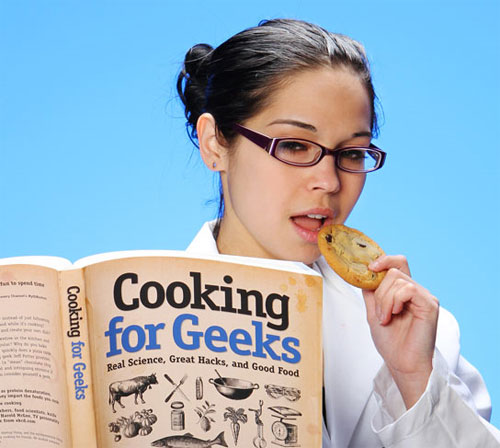
Find out what goes on behind closed doors in the kitchen. The closed door of the oven, that is. Cooking for Geeks, written by Jeff Potter, is a cookbook that goes beyond recipes and adds a little more spice to the mix. In it, you will learn:
• Why medium-rare steak is so popular.
• Why we bake some things at 350° F/175° C and others at 375° F/190° C.
• How quickly a pizza will cook if we overclock an oven to 1,000° F/540° C.
• How to initialize your kitchen and calibrate your tools.
• Important reactions in cooking, such as protein denaturation, Maillard reactions, and caramelization, and how they impact the foods we cook.
• How to play with your food using hydrocolloids and sous vide cooking.
Read on for a couple of sample recipes.
Butternut Squash Soup
Purée in a food processor or with an immersion blender:
2 cups (660g) butternut squash, peeled, cubed, and roasted (about 1 medium squash)
2 cups (470g) chicken, turkey, or vegetable stock
1 small (130g) yellow onion, diced and sautéed
1/2 teaspoon (1g) salt (adjust to taste)
Notes
* The weights are for the prepared ingredients and only rough suggestions. So, prepare each item individually. For example, for the squash, peel it, then coat it with olive oil, sprinkle it with salt, and roast it in the oven at a temperature around 400–425 F / 200–220 C until it begins to brown. When you go to purée the ingredients, hold back some of the squash and some of the stock, taste the purée, and see which you think it needs. Want it thicker? Add more squash. Thinner? Add more stock.
* This soup by itself is very basic. Garnish with whatever else you have on hand that you think might go well, such as garlic croutons and bacon. Or top with a small dab of cream, some toasted walnuts, and dried cranberries to give it a feeling of Thanksgiving. How about a teaspoon of maple syrup, a few thin slices of beef, and some fresh oregano? Chives, sour cream, and cheddar cheese? Why not! Instead of purchasing items to follow a recipe exactly, try using leftover ingredients from other meals to complement the squash soup.
* If you’re in a rush, you can “jump-start†the squash by microwaving it first. Peel and quarter the squash, using a spoon to scoop out the seeds. Then, cube it into 1–2†/ 3–5 cm pieces, drop it into a glass baking pan that’s both oven and microwave safe, and nuke it for four to five minutes to partially heat the mass. Remove from microwave, coat the squash with olive oil and a light sprinkling of salt, and roast it in a preheated oven until done, about 20 to 30 minutes. If you’re not in a rush, you can skip the peeling step entirely: cut the squash in half, scoop out the seeds, add oil and salt, roast it for about an hour (until the flesh is soft), and use a spoon to scoop it out.
Pumpkin Cake
There are two broad types of cake batters: high- ratio cakes–those that have more sugar and water than flour (or by some definitions, just a lot of sugar)–and low-ratio cakes—which tend to have coarser crumbs. For high-ratio cakes, there should be more sugar than flour (by weight) and more eggs than fats (again, by weight), and the liquid mass (eggs, milk, water) should be heavier than the sugar.
Consider this pumpkin cake, which is a high-ratio cake (245g of pumpkin contains 220g of water–you can look these sorts of things up in the USDA National Nutrient Database, available online at http://www.nal.usda.gov/fnic/foodcomp/search/).
In a mixing bowl, measure out and then mix with an electric mixer to thoroughly combine:
1 cup (245g) pumpkin (canned, or roast and puree your own)
1 cup (200g) sugar
3/4 cup (160g) canola oil
2 large (120g) eggs
1 1/2 cups (180g) flour
1/4 cup (40g) raisins
2 teaspoons (5g) cinnamon
1 teaspoon (5g) baking powder
1/2 teaspoon (5g) baking soda
1/2 teaspoon (3g) salt
1/2 teaspoon (2g) vanilla extract
Transfer to a greased cake pan or spring form and bake in an oven preheated to 350 F / 175 C until a toothpick comes out dry, about 20 minutes.
Notes
* Try adding dried pears soaked in brandy. You can also hold back some of the raisins and sprinkle them on top.
* One nice thing about high-ratio cakes is that they don’t have much gluten, so they won’t turn out like bread, even with excessive beating. With a total weight of 920 grams, of which only roughly 20 grams is gluten, there just isn’t enough gluten present in this cake to give it a bread-like texture. There’s also a fair amount of both sugar and fats to interfere with gluten development.
